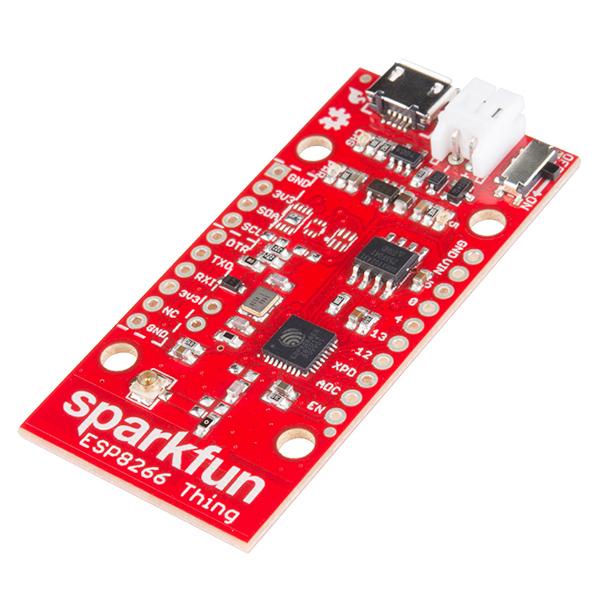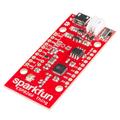SparkFun ESP8266 Thing

Description Attachments
The SparkFun ESP8266 Thing, affectionately referred to as the "Thing", is the ideal base for any Internet of Things project. It can perform a wide range of tasks, from activating an LED to posting data with datastream, and can be programmed like any microcontroller. The Thing can also be programmed through the Arduino IDE by installing the ESP8266 Arduino addon.
The layout of the SparkFun ESP8266 Thing is straightforward. The pins are broken out to two parallel, breadboard-compatible rows. USB and LiPo connectors at the top of the board provide power, controlled by the nearby ON/OFF switch. LEDs towards the inside of the board indicate power, charge, and status of the IC. The ESP8266’s maximum voltage is 3.6V, so the Thing includes an onboard 3.3V regulator to deliver a safe, consistent voltage to the IC. This means the ESP8266’s I/O pins also run at 3.3V, requiring level shifting for any 5V signals running into the IC. A 3.3V FTDI Basic is needed to program the SparkFun ESP8266 Thing, but other serial converters with 3.3V I/O levels should work just fine. The converter will need a DTR line in addition to the RX and TX pins.
Features of the SparkFun ESP8266 Thing include all module pins broken out, an on-board LiPo charger/power supply, 802.11 b/g/n, Wi-Fi Direct (P2P), soft-AP, an integrated TCP/IP protocol stack, an integrated TR switch, balun, LNA, power amplifier and matching network, integrated PLLs, regulators, DCXO and power management units, an integrated low power 32-bit CPU that could be used as an application processor, and a +19.5dBm output power in 802.11b mode.
For additional information, consider looking at the schematic, Eagle Files, Hookup Guide, ESP8266 Powered Propane Poofer, Graphical Datasheet, and the GitHub Hardware Repo.
Properties
| Brand | Sparkfun |
| Model | WRL-13231 |
| More info | ESP8266 Thing Hookup Guide - SparkFun Learn |
Alternative products
Customer questions
Customer Reviews
- In stock Sparkfun Copper Tape - Conductive Adhesive, 5mm - 15 meter € 7,75 View product
- In stock Sparkfun Teensy Stackable Header Kit (Extended) € 2,90 View product
- In stock Sparkfun Hobby Motor - Gear € 3,50 View product
- In stock Sparkfun Battery Holder 2xAA with Cover and Switch - JST Connector € 2,60 View product
- Sale In stock -72 % Sparkfun EasyDriver - Stepper Motor Driver € 21,25 € 6,05 View product
- In stock Sparkfun Thin Speaker - 4 Ohm, 2.5W, 28mm € 3,- View product
- In stock Sparkfun Alligator Clip with Pigtail (4 Pack) € 6,- View product
- In stock Sparkfun Toggle Switch € 3,30 View product
- In stock Sparkfun Clear Plastic Knob € 1,75 View product
- In stock Sparkfun Resistor 1K Ohm 1/4 Watt PTH - 20 pack (Thick Leads) € 2,15 View product
- In stock SparkFun Logic Level Converter - Bi-Directional € 5,15 View product
- In stock SparkFun Serial Basic Breakout - CH340G € 11,50 View product
- In stock Sparkfun Super Capacitor - 10F/2.5V € 6,25 View product
- In stock SparkFun Nano Power Timer - TPL5110 € 10,95 View product
- In stock Sparkfun Mini Photocell € 2,25 View product










